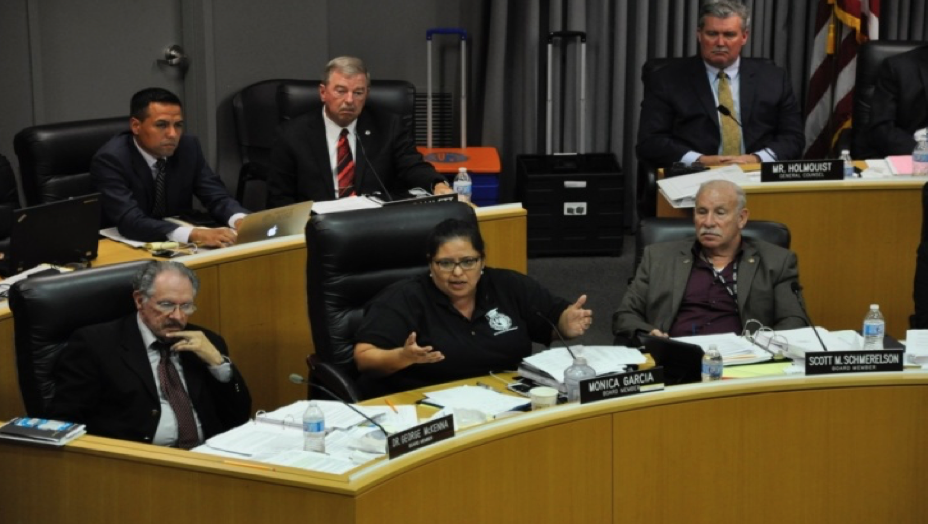CommentsEDUCATION POLITICS-Facing a $468 million budget shortfall by 2021-22, LAUSD officials are now seeking a flat $610 property parcel tax to raise approximately $500 million annually.
But given the two-thirds majority vote required to enact such a parcel tax in either November 2018 or 2020, it is doubtful such a tax would pass.
As a former history teacher LAUSD (before they fired me for being a whistleblower who reported they were fixing grades and attendance) let me give you a short lesson about LAUSD’s endemic financial corruption that should motivate you to vote AGAINST any such parcel tax. The District has a record of being more concerned with the well-being of its vendors and entrenched overpaid bureaucracy than with educating its predominantly minority students who have had the misfortune of being continuously socially promoted without receiving even the most basic academic skills.
As Edmund Burke once said, "Those who don't know their history are doomed to repeat it." So, let's review a few of the many factors that have led to the projected $468 million budget shortfall which I believe is just the tip of the iceberg of the corruption that will ultimately bankrupt LAUSD in the not too distant future with or without this parcel tax.
- Charter schools -- LAUSD has been hemorrhaging Average Daily Attendance monies and other funds coming from the State and Federal government as more and more students are being funneled into charter schools, which ironically are no better and often worst than LAUSD. With fixed expenses that are not significantly lessened by the loss of these students, this is a major factor pushing LAUSD into bankruptcy. That and the fact that the majority of the LAUSD Board were put in by the well-funded charter lobby to assure nothing is done at LAUSD to challenge charters.
- Agreed vendors -- Theoretically, the only reason to have a school district the size of LAUSD -- which is the second largest in the country -- has to do with the “economics of scale.” This means a larger business entity buying greater amounts of goods and services should be able to get a better price. But at LAUSD -- and from what I hear at LA Country schools as -- LAUSD doesn't get a better price, but rather pays morebecause it can only buy from its "agreed vendors" of goods and services. This is true for all the goods and services it buys. In the final analysis, not only does LAUSD's size notget it a better price; it has also made it next to impossible to hold anyone responsible for the collusive behavior that exists within the LAUSD administrative culture that promotes employees in direct relationship to their willingness to go along with whatever its entrenched corrupt leadership decides -- legal or otherwise.
- Belmont and JFK Learning Center -- Belmont was built on an irremediable toxic waste oil field site where the off-gassing made it impossible to use it safely as a school -- unless as one expert said, they built “the buildings 16 feet off the ground." Beverly Hills High School had only one oil well next to the track field and years later, students who had been exposed to well's toxins have been coming down with cancer and other diseases attributable to that exposure.
The mega law firm O'Melveny and Myers -- which had an undisclosed conflict of interest in representing both LAUSD and the contractor of the Belmont site -- was bailed out by ex-Mayor Richard Riordan who then populated the Belmont site with mostly Latino children. He bogusly claimed that there had not been millions of dollars in damages to LAUSD from building on this toxic site, as alleged in the law suit against O'Melveny, since the school was now filled with students.
Short of a parcel tax, I would be happy to show LAUSD how it could save far more than $500 million by implementing some common-sense programs. Here's one possible short-term solution, followed by two longer term solutions:
- How much money would LAUSD save in school maintenance and upkeep costs, if students were required to clean up the campus and rooms after themselves?
- If the vibrant Industrial Arts program that once existed at LAUSD were reinstituted, how much electrical, plumbing, and other construction trades could students be educated to do at a fraction of the present cost? This would allow them to learn a trade while also maintaining their own schools.
- And finally, if students were educated in a timely manner, how much money now being spent in the juvenile and adult criminal justice systems could be repurposed back into public education? It costs far less to educate students than to incarcerate them later.
(Leonard Isenberg is a Los Angeles, observer and a contributor to CityWatch. He was a second- generation teacher at LAUSD and blogs at perdaily.com. Leonard can be reached at [email protected].) Edited for CityWatch by Linda Abrams.
















